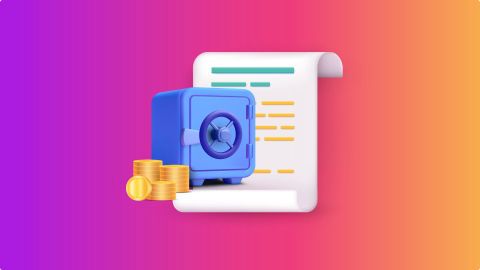A dormant account is a term used to describe a bank account that has remained inactive for an extended period. While many people might not think much about an account they rarely use, it’s important to understand what happens when an account becomes dormant, the implications of having a dormant account, and how to reactivate it if needed. In this article, we will explore what a dormant account is, how it can impact you, and the steps you can take to manage or reactivate such accounts.
What is a dormant account?
A dormant account is a bank account that has had no financial activity for a specific period, usually 12 to 24 months, depending on the bank’s policy. Financial activity typically includes transactions like deposits, withdrawals, fund transfers, or even using the account for direct debits or standing orders. If none of these activities occur within the specified timeframe, the bank may classify the account as dormant.
Once an account is labeled as dormant, it remains in the bank's records, but certain restrictions may be applied. For example, the account holder may not be able to withdraw funds or issue cheques without first reactivating the account.
Why do accounts become dormant?
There are several reasons why a bank account might become dormant:
- Multiple accounts: Some individuals open multiple bank accounts for various purposes, such as savings, investments, or specific financial goals. Over time, they may stop using one or more of these accounts, leading to inactivity.
- Change in financial circumstances: A change in financial circumstances, such as job loss, relocation, or a shift in banking preferences, can result in an account being left unused.
- Neglect: Sometimes, people simply forget about an account, especially if it has a small balance or if they rarely used it in the first place.
- Long-Term Investments: Accounts that are opened for long-term investments or specific purposes (like a fixed deposit) may not see regular transactions, leading to dormancy.
What happens when an account becomes dormant?
When a bank account becomes dormant, it remains in the bank’s system, but certain limitations are imposed. Here are some of the common consequences:
- Restricted access: The account holder may face restrictions on transactions, such as withdrawing money, issuing cheques, or using a debit card. Online banking services linked to the account may also be limited.
- Account fees: Some banks charge maintenance fees on dormant accounts. These fees can gradually deplete the balance, especially if the account was left with a small amount of money.
- Interest earnings: If the account earns interest, it may continue to do so even while dormant. However, this interest might be subject to fees, and the bank may impose a lower interest rate on dormant accounts.
- Communication from the bank: Banks typically attempt to contact the account holder before classifying an account as dormant. They may send notifications, letters, or emails to inform the account holder of the inactivity and the steps required to prevent the account from becoming dormant.
- Reactivation process: To use a dormant account, the account holder must reactivate it by following the bank's procedures. This usually involves visiting the bank, verifying identity, and possibly completing some paperwork.
How to prevent an account from becoming dormant
Preventing your bank account from becoming dormant is relatively simple. Here are a few steps you can take:
- Regular transactions: Ensure that you carry out at least one transaction every 6 to 12 months. This could be as simple as depositing or withdrawing a small amount, transferring funds, or using your debit card.
- Set up direct debits: Linking your account to recurring payments, such as utility bills or subscriptions, can help maintain activity in the account.
- Monitor your accounts: Regularly check all your bank accounts, even those you rarely use. This will help you stay on top of any changes and avoid dormancy.
- Consolidate accounts: If you have multiple bank accounts, consider consolidating them. This reduces the number of accounts you need to manage and lowers the risk of one becoming dormant.
- Notify the bank: If you know that you won’t be using an account for an extended period, notify your bank. They may offer advice on how to keep the account active or suggest alternatives.
Difference between inactive and dormant bank accounts
- Inactive account: An account becomes inactive when it hasn't been used for a shorter period, typically 6 months to a year. The account remains functional, but the bank monitors it more closely for security purposes.
- Dormant account: If an account remains unused beyond the inactive period, it is classified as dormant. At this stage, access to the account is significantly restricted to protect against potential fraud.
How to reactivate a dormant account
If your account has already become dormant, don’t worry—it can usually be reactivated. Here’s how:
- Visit the bank: Most banks require you to visit a branch in person to reactivate a dormant account. Make sure to bring valid identification and any account-related documents.
- Submit a written request: You may need to submit a written request to reactivate the account. Some banks provide forms for this purpose, while others may accept a simple letter.
- Verify your identity: Banks will typically ask you to verify your identity to ensure that you are the rightful account holder. This is an essential security step.
- Conduct a transaction: After reactivating the account, you will likely be required to conduct a transaction, such as a deposit or withdrawal, to make the account fully operational again.
- Review account details: Once the account is reactivated, review the account details, including any fees or changes that may have occurred while the account was dormant. Update your contact information if necessary.
Conclusion
A dormant account may seem like a minor issue, but it’s important to understand its implications. Inactivity can lead to restricted access, account fees, and other complications. By staying proactive, you can prevent your account from becoming dormant, and if it does happen, reactivation is typically straightforward. Regularly monitoring your accounts, conducting transactions, and keeping in touch with your bank can help you avoid the inconvenience of a dormant account. Being aware of your financial accounts and maintaining their activity is a simple yet effective way to ensure that your money remains accessible and secure.
If you are looking for safe investment option, then you can consider investing Bajaj Finance Fixed Deposit. With a top-tier AAA rating from financial agencies like CRISIL and ICRA, they offer one of the highest returns, up to 8.60% p.a.








 Food & Beverages
Food & Beverages Fashion
Fashion Beauty & Personal Care
Beauty & Personal Care Health & Wellness
Health & Wellness Home & Kitchen
Home & Kitchen

 Loan Against Shares
Loan Against Shares Loan Against Mutual Funds
Loan Against Mutual Funds Loan Against Bonds
Loan Against Bonds Loan Against Insurance Policy
Loan Against Insurance Policy ESOP Financing
ESOP Financing Two-wheeler Loan
Two-wheeler Loan Loan for Lawyer
Loan for Lawyer Industrial Equipment Finance
Industrial Equipment Finance Industrial Equipment Balance Transfer
Industrial Equipment Balance Transfer Industrial Equipment Refinance
Industrial Equipment Refinance
 Smartphones
Smartphones Air Conditioner
Air Conditioner Led TVs
Led TVs Air Coolers
Air Coolers Refrigerators
Refrigerators Washing Machines
Washing Machines Laptops
Laptops

 Trading Account
Trading Account Open Demat Account
Open Demat Account Margin Trading Financing
Margin Trading Financing Share Market
Share Market Invest in IPO
Invest in IPO All stocks
All stocks Top gainers
Top gainers Top losers
Top losers 52 week high
52 week high 52 week low
52 week low
 Business Loan
Business Loan Secured Business Loan
Secured Business Loan Loan against property
Loan against property Loans against property balance transfer
Loans against property balance transfer Loan against shares
Loan against shares Home Loan
Home Loan Loans against mutual funds
Loans against mutual funds Loan against bonds
Loan against bonds Loan against insurance policy
Loan against insurance policy
 Term Life Insurance
Term Life Insurance ULIP Plan
ULIP Plan Savings Plan
Savings Plan Retirement Plans
Retirement Plans Child Plans
Child Plans Investment Plans
Investment Plans
 Get Bajaj Prime
Get Bajaj Prime
 ULIP Plan
ULIP Plan Savings Plan
Savings Plan Retirement Plans
Retirement Plans Child Plans
Child Plans Free Demat Account
Free Demat Account Invest in IPO
Invest in IPO Invest in Stocks
Invest in Stocks Margin Trading Facility
Margin Trading Facility
 Check your Credit Score
Check your Credit Score
 Bike
Bike Scooter
Scooter Electric Vehicle
Electric Vehicle Best Sellers
Best Sellers Popular Brands
Popular Brands
 New Car Loan
New Car Loan Used Car Loan
Used Car Loan Loan Against Car
Loan Against Car Car Loan Balance Transfer and Top-up
Car Loan Balance Transfer and Top-up
 Engagement Zone
Engagement Zone Game Zone
Game Zone
 Personal Loan EMI Calculator
Personal Loan EMI Calculator Personal Loan Eligibility Calculator
Personal Loan Eligibility Calculator Home Loan EMI Calculator
Home Loan EMI Calculator Home Loan Eligibility Calculator
Home Loan Eligibility Calculator Good & Service Tax (GST) Calculator
Good & Service Tax (GST) Calculator Flexi Day Wise Interest Calculator
Flexi Day Wise Interest Calculator Flexi Transaction Calculator
Flexi Transaction Calculator Secured Business Loan Eligibility Calculator
Secured Business Loan Eligibility Calculator Fixed Deposits Interest Calculator
Fixed Deposits Interest Calculator Two wheeler Loan EMI Calculator
Two wheeler Loan EMI Calculator New Car Loan EMI Calculator
New Car Loan EMI Calculator Used Car Loan EMI Calculator
Used Car Loan EMI Calculator All Calculator
All Calculator
 Hot Deals
Hot Deals Clearance Sale
Clearance Sale Kitchen Appliances
Kitchen Appliances Tyres
Tyres Camera & Accessories
Camera & Accessories Mattresses
Mattresses Furniture
Furniture Watches
Watches Music & Audio
Music & Audio Cycles
Cycles Mixer & Grinder
Mixer & Grinder Luggage & Travel
Luggage & Travel Fitness Equipment
Fitness Equipment Fans
Fans
 Personal Loan for Doctors
Personal Loan for Doctors Business loan for Doctors
Business loan for Doctors Medical Equipment Finance
Medical Equipment Finance Secured Business Loan
Secured Business Loan Loan against property
Loan against property Loan against share
Loan against share Gold Loan
Gold Loan Home Loan
Home Loan
 Smartphones
Smartphones Air Conditioners
Air Conditioners LED TVs
LED TVs Air Coolers
Air Coolers Refrigerators
Refrigerators Washing Machines
Washing Machines Laptops
Laptops Water Purifiers
Water Purifiers Tablets
Tablets Kitchen Appliances
Kitchen Appliances Mattresses
Mattresses Furniture
Furniture Music and Audio
Music and Audio Cameras & Accessories
Cameras & Accessories Cycle
Cycle Watches
Watches Tyres
Tyres Luggage & Travel
Luggage & Travel Fitness Equipment
Fitness Equipment
 Home Loan
Home Loan Transfer your existing Home loan
Transfer your existing Home loan Loan against Property
Loan against Property Home Loan for Salaried
Home Loan for Salaried Home loan for self employed
Home loan for self employed Home Loan EMI Calculator
Home Loan EMI Calculator Home Loan eligibility calculator
Home Loan eligibility calculator Home Loan balance transfer
Home Loan balance transfer
 Offer World
Offer World
 Articles
Articles
 Overdue Payments
Overdue Payments Other Payments
Other Payments
 Document Center
Document Center Bank details & Documents
Bank details & Documents Tax Invoice Certificate
Tax Invoice Certificate
 Do Not Call Service
Do Not Call Service
 Your Orders
Your Orders Hamara Mall Orders
Hamara Mall Orders

 Fixed Deposit (IFA) Partner
Fixed Deposit (IFA) Partner Loan (DSA) Partner
Loan (DSA) Partner Debt Management Partner
Debt Management Partner EMI Network Partner
EMI Network Partner Become a Merchant
Become a Merchant Partner Sign-in
Partner Sign-in
 Food & Shopping
Food & Shopping Credit Card Hub
Credit Card Hub ULIP Plans
ULIP Plans Top Gainers Stock
Top Gainers Stock Top Losers Stock
Top Losers Stock Saving Plan
Saving Plan Term Insurance
Term Insurance
 Live Videos
Live Videos














